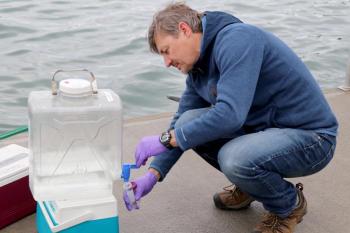$6 million grant launches innovative genetic research at Bigelow Laboratory
 Bigelow Laboratory scientist Ramunas Stepanauskas collects a water sample on the institute’s dock. He is the principle investigator on a new $6 million project that will connect the genetic makeup of individual microbes to their environmental roles and build economic capacity in Maine, New Hampshire and Nevada. Courtesy of Bigelow Laboratory for Ocean Sciences
Bigelow Laboratory scientist Ramunas Stepanauskas collects a water sample on the institute’s dock. He is the principle investigator on a new $6 million project that will connect the genetic makeup of individual microbes to their environmental roles and build economic capacity in Maine, New Hampshire and Nevada. Courtesy of Bigelow Laboratory for Ocean Sciences
 Bigelow Laboratory scientist Nicole Poulton sorts microbes in the institute's Single Cell Genomics Center. A new $6 million project will connect the genetic makeup of individual microbes to their environmental roles and build economic capacity in Maine, New Hampshire and Nevada. Greta Rybus photo
Bigelow Laboratory scientist Nicole Poulton sorts microbes in the institute's Single Cell Genomics Center. A new $6 million project will connect the genetic makeup of individual microbes to their environmental roles and build economic capacity in Maine, New Hampshire and Nevada. Greta Rybus photo
 Bigelow Laboratory scientists Ramunas Stepanauskas and Laura Lubelczyk work with University of New Hampshire scientist Kai Ziervogel to collect water for analysis from the Bigelow Laboratory dock. A new $6 million project will connect the genetic makeup of individual microbes to their environmental roles and build economic capacity in Maine, New Hampshire and Nevada. Courtesy of Bigelow Laboratory for Ocean Sciences
Bigelow Laboratory scientists Ramunas Stepanauskas and Laura Lubelczyk work with University of New Hampshire scientist Kai Ziervogel to collect water for analysis from the Bigelow Laboratory dock. A new $6 million project will connect the genetic makeup of individual microbes to their environmental roles and build economic capacity in Maine, New Hampshire and Nevada. Courtesy of Bigelow Laboratory for Ocean Sciences
 Bigelow Laboratory scientist Ramunas Stepanauskas collects a water sample on the institute’s dock. He is the principle investigator on a new $6 million project that will connect the genetic makeup of individual microbes to their environmental roles and build economic capacity in Maine, New Hampshire and Nevada. Courtesy of Bigelow Laboratory for Ocean Sciences
Bigelow Laboratory scientist Ramunas Stepanauskas collects a water sample on the institute’s dock. He is the principle investigator on a new $6 million project that will connect the genetic makeup of individual microbes to their environmental roles and build economic capacity in Maine, New Hampshire and Nevada. Courtesy of Bigelow Laboratory for Ocean Sciences
 Bigelow Laboratory scientist Nicole Poulton sorts microbes in the institute's Single Cell Genomics Center. A new $6 million project will connect the genetic makeup of individual microbes to their environmental roles and build economic capacity in Maine, New Hampshire and Nevada. Greta Rybus photo
Bigelow Laboratory scientist Nicole Poulton sorts microbes in the institute's Single Cell Genomics Center. A new $6 million project will connect the genetic makeup of individual microbes to their environmental roles and build economic capacity in Maine, New Hampshire and Nevada. Greta Rybus photo
 Bigelow Laboratory scientists Ramunas Stepanauskas and Laura Lubelczyk work with University of New Hampshire scientist Kai Ziervogel to collect water for analysis from the Bigelow Laboratory dock. A new $6 million project will connect the genetic makeup of individual microbes to their environmental roles and build economic capacity in Maine, New Hampshire and Nevada. Courtesy of Bigelow Laboratory for Ocean Sciences
Bigelow Laboratory scientists Ramunas Stepanauskas and Laura Lubelczyk work with University of New Hampshire scientist Kai Ziervogel to collect water for analysis from the Bigelow Laboratory dock. A new $6 million project will connect the genetic makeup of individual microbes to their environmental roles and build economic capacity in Maine, New Hampshire and Nevada. Courtesy of Bigelow Laboratory for Ocean Sciences
Bigelow Laboratory for Ocean Sciences in East Boothbay has announced receipt of a $6 million National Science Foundation grant that will empower the institute to develop new genetic research technologies and build economic capacity in Maine, New Hampshire and Nevada. The multifaceted effort, which the researchers will launch next week at the National Science Foundation in Washington, D.C., aims to unlock the genomic data of microscopic organisms that drive major chemical cycles and shape global climate.
“There has been an explosion of genomics data over the last two decades, and the next step is connecting that data to what’s actually happening in the environment,” said Ramunas Stepanauskas, director of the Single Cell Genomics Center at Bigelow Laboratory and principal investigator on the project. “We need new infrastructure and approaches to harness the power of genomic technologies, which will help solve some of the great biological mysteries of our planet.”
The four-year project will develop and apply new tools to connect the functions of individual microbes to their genetic makeup in diverse marine and continental environments. Bigelow Laboratory researchers Beth Orcutt, Nicole Poulton and David Emerson will work alongside Stepanauskas, as well as co-investigators at University of New Hampshire and the Desert Research Institute.
“Combing single-cell genomics with measurements of microbial metabolism will help us better understand the role of microbes in cycling biologically important compounds,” said Kai Ziervogel, the microbial biogeochemist leading project efforts at University of New Hampshire. “I am excited that this project will provide undergraduate and graduate students opportunities to participate in interdisciplinary research that will contribute to environmental science in a unique way.”
The project funds come from the Established Program to Stimulate Competitive Research (EPSCoR), which aims to strengthen the research and technology capacity of states that have historically received low federal research funding. The project leverages Bigelow Laboratory’s state-of-the-art capacity in single cell genomics and flow cytometry, University of New Hampshire’s expertise in polymers in the environment and synthesis of fluorescently labeled tracer molecules, and the Desert Research Institute’s experience studying both subsurface environments and how microbes degrade contaminants.
As the project progresses, the research team will hone their new infrastructure approach and apply it to increasingly complex questions and environments, examining microbes collected from the Gulf of Maine, the deep ocean, and the marine and continental subsurface.
“This project allows us to eavesdrop on mysterious groups of deep biosphere microorganisms at the level of the individual cell,” said Duane Moser, co-investigator at the Desert Research Institute who will also adapt the new technologies for environmental bioremediation applications. “These new tools will enable us to identify and differentiate specific microorganisms from complex communities that break down manmade contaminants in the environment.”
In addition to creating new research infrastructure, the project will spur economic growth through skilled workforce training opportunities and several new jobs -- including new senior research scientist and postdoctoral positions at Bigelow Laboratory, a new postdoctoral scientist at the Desert Research Institute, and a faculty member at University of New Hampshire.
The research team will also provide professional development opportunities, including bioinformatics workshops for people in Maine, New Hampshire and Nevada. During the fall of 2019, Bigelow Laboratory will host its fourth single cell genomics conference, which will gather experts in this cutting-edge field to the Boothbay area.
“As we improve our understanding of the critical functions of life, we can also improve our three collaborating states,” Stepanauskas said. “By enabling novel research, educational programs and workforce development, this work will have broad impacts on the research community and beyond.”
Event Date
Address
United States


























